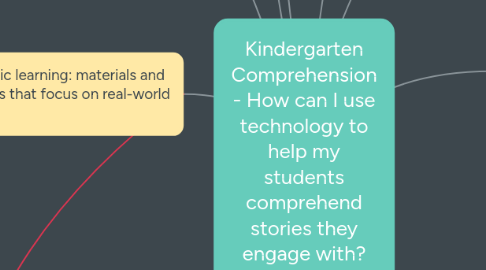
1. Learning with technology
1.1. Use technology to think with and show learning.
1.1.1. Students read along with the listening centre. Provided with audio and a copy of the book. Engaged.
1.1.2. QR codes on students drawings/stories with them telling the story. Especially great for assessment.
2. Learning Objective: talks and represents to explore, express and share stories, ideas and experiences
2.1. Students use stories with and without words and use the pictures to create their own stories.
2.1.1. ScratchJR: students can create their own stories.
3. Learning Objective: student participates in shared listening, reading and viewing experiences, using oral, print and other media texts.
3.1. Listening centre during centre time with stories previously read during story time.
3.2. Reading several times a day. Reading the same story numerous times. Reading stories by the same author with the same structure.
3.3. YouTube readalouds
3.4. SMARTboard sequencing activities where students have the opportunity to manipulate the story cards on the board. This provides an opportunity for collaboration between classmates.
4. Learning Objective: Student talks about and represents the actions of characters portrayed in oral, print and other media texts
5. Meaningful Learning: gaining relevant knowledge to solve problems and understand new concepts and solve new problems.
5.1. Transfer test: use the material learned in a new situation.
5.1.1. Specific transfer: aspects of A are required in B.
5.1.1.1. Phrases from Pete the Cat I Love My White Shoes are the same in Pete the Cat Rocking in My School Shoes and Pete the Cat My Four Groovy Buttons. Students can successfully transfer their knowledge from the first book to predict the phrases and the structure.
5.2. Students are aware of the purpose of what they are learning or the learning objective.
5.2.1. For each Pete the Cat lesson students are given an I can statement for the learning intention. Ex. I can retell the Pete the Cat I love My White Shoes story, I Can talk about what Pete steps in in the story, I can match words with pictures, etc.
5.3. Cognitive process: integrating - making connections between representations in the working memory and prior knowledge.
5.3.1. Concrete advanced organizer: familiar material presented before.
5.3.1.1. Before introducing a Pete the Cat Rocking in My School Shoes, reread Pete the Cat I Love my White Shoes, students will feel more comfortable and will be able to predict the common phrases and structure of the new story.
6. Authentic learning: materials and activities that focus on real-world tasks.
6.1. Authentic context: the environment reflects the way the knowledge will be used in real life.
6.1.1. Pete the Cat unit: Students will learn to make connections for use in the classroom.
6.1.1.1. Connections between pictures and words when reading and writing.
6.1.1.2. Connections between books by the same author.
6.1.1.3. Connections between the events in the story.
6.2. Authentic task: tasks and activities with real world relevance.
6.2.1. Use of stories that students are familiar with and read often.
6.2.1.1. Pete the Cat is a familiar story for Kindergarten aged students.
6.2.1.2. Pete the Cat stories follow a familiar structure often with a song which helps with students being able to remember the words.
6.2.2. Tasks with real world relevance could include: writing a recipe, making a list, making an invitation, making our own classroom book.
6.2.2.1. For Pete the Cat Rocking in My School Shoes students could write out their daily school schedule in the structure of the Pete the Cat story.
6.2.2.2. Students work together to create our own version of a Pete the Cat book. Last year my class wrote and illustrated a collection of books including a Pete the Cat book which are all a part of the school library and available to check out for any student in the school.
6.2.2.3. Integrate storytelling into dramatic play.
6.2.2.3.1. Using puppets to retell or acting out the story.
6.3. Authentic assessment: provide feedback (formative assessment)
6.3.1. Pete the Cat self assessment: create a writing checklist with students. Ex. Did I write my name? Does my picture match my story? Did I color my picture? The rating scale could be a happy face and a sad face.
7. Learning Objective: Student begins to use language prediction skills when stories are read aloud
7.1. Learning Objective: asks questions and makes comments during read aloud
8. Learning Objective: recalls events and characters
8.1. Students are able to read/repeat the story after hearing it being read aloud numerous times.
8.1.1. Pete the Cat sequencing activity to retell
9. Learning Objective: Students connect oral language with print and pictures.
9.1. Students learn that print and pictures have meaning and are related to each other in stories.
9.1.1. Label the pictutes in the book. Identify key words. Pete the Cat I Love My White Shoes color code the color words.
